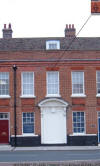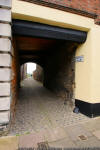|
Hidden East Anglia: Landscape Legends of Eastern England
|
||
|
|
Kenninghall:
Candleyards Boudicca is said to have had a palace here at a moated site called Candleyards, which might be the moat (TM065855) just west of Kenninghall Place. Source: Arthur Mee (ed.) : 'The King's England - Norfolk' (Hodder & Stoughton, 1940), p.205.
Secret tunnels Legend says that a tunnel once ran between Greyfriars Priory (TF621198) and the curious Red Mount Chapel (TF624199). Another tunnel, now bricked-up, was also thought to have connected the priory to the White Hart pub, both in St. James Street. The pub itself is supposed to be haunted by a monk. Nothing is left of the 13th century Franciscan priory except the lofty Lantern Tower, while the Red Mount Chapel is a unique and mysterious structure, about which opinion has always been divided. The structure itself is of red brick, octagonal and buttressed, with an inner rectangular core that projects above the roof. There are actually two chapels here, one possibly of the 13th century, and the other - the Chapel of Our Lady of the Mount - was set upon the steep-sided artificial mound in about 1485 by Robert Corraunce. This was probably to house a holy relic of the Blessed Virgin Mary, and tradition tells of pilgrims halting here on their way to Walsingham.
Because of the other main story associated with it (set in the 1300s)
it's possible an earlier edifice stood here - an idea even more probable given that the mound
itself was once known as Guanock Hill - 'guanock' or 'gannock' bein In 1331 Isabella, the widow of King Edward II, was brought to the castle by her son and allegedly imprisoned for her part in Mortimer's rebellion. However, she wasn't even under house arrest, as she travelled quite freely in this country and abroad. She was said to have been jailed here until her death in 1358, and buried in Rising church. Thus, Edward III was believed to have used the tunnel on many occasions to secretly visit his mother. However, she actually died at Hertford Castle and was almost certainly buried at Greyfriars in London. The historian of Lynn, Mr. E. M. Beloe, dug at the Red Mount and found that the supposed tunnel came to a halt after only a few feet, at an outer door which had long been buried beneath the soil of the mound. The door in the castle was likewise no more than one of two entrances to an inner stairway. As in other subterranean tales, a drunken fiddler and his dog are said to have tried to explore the tunnel, but were never seen again.
Another tunnel supposedly comes to Lynn from the site of the former medieval bishop's palace where Gaywood Hall (TF639200) now stands, in an eastern suburb of the town. A brick arch uncovered in a trench along Blackfriars Road was claimed by one old man to be evidence of this, while another is said to have dug up a tunnel on the same line during the last century, but veering towards the Red Mount. Sewers and a covered-up reservoir may have been the basis for this any other such stories.
In St. James Street is the White Hart pub (TF618198), radically rebuilt in the mid-19th century, but dating from at least 200 years earlier. A shadowy, hooded figure that haunts the pub is said to be a ghostly monk, who has passed through a legendary tunnel from St. Margaret's church in the Saturday Market Place.
The medieval St. George's Guildhall (TF616202) in King Street is now home to an arts centre, coffee shop, and other businesses, but beneath it is an actual tunnel (now stopped-up and dry), through which merchants brought goods from their boats on the nearby Great Ouse river. Vaulted undercrofts exist here and beneath former medieval warehouses along King Street as far as the Tuesday Market Place, but it seems to be rumour only that other tunnels honeycomb the area.
Sources: Walter Rye: 'Norfolk Songs, Stories & Sayings' (Goose & Son, 1897), pp.85-6. 'The East Anglian Magazine', Vol.2, p.461. http://www.paranormaldatabase.com/hotspots/kingslynn.php http://www.heritage.norfolk.gov.uk-King's Lynn www.kingslynn-forums.co.uk-tunnel2 Ann Weaver: 'The Ghosts of King's Lynn' in KL Magazine, Issue 1, Oct. 2010, p.51. https://www.edp24.co.uk/lifestyle/21119202.secret-tunnel-kings-lynn-arts-centre/
Source: Arthur Randell (ed. Enid Porter: ‘Sixty Years a Fenman’ (R & K P, 1966). P.102-3.
Source: Enid Porter: 'The Folklore of East Anglia' (Batsford, 1974), p.137-8.
It was once completely roofed like a tunnel, running from there to the quayside. Rather than an imprint in the ground, one source says that that the alley "showed at its darkest point a queer cobble in the pavement shaped like a gigantic human foot".3 Why it was associated with the Devil is unknown, but people apparently were in the habit of spitting on it as they went by.2 Certainly nothing of the like is visible there now, and the story may not be all that old - as in 1881 the lane was actually called Miller's Alley.
Sources: 1. Julia Skinner (compiler): 'Did You Know? King's Lynn: a Miscellany' (Francis Frith Collection, 2009), p.5. 2. Paul Lee, Facebook posts 29/8/2022, on the 'Norfolk Tales and Myth's page. 3. G. G. Coulton: 'Fourscore Years: an Autobiography' (Readers Union, 1945), p.32.
Hard by the east end of the St. Nicholas Chapel mentioned above runs Pilot Street. Now much reduced in length, before 1809 it was known as Dowshill. Going back into the Middle Ages, it was also spelt Deucehill, Douz hill and Duse hill. 'Deuce' and 'duse' were old words used to describe demons or the Devil, so it's been theorised that the area was a known haunt of fiends or goblins - although no actual folklore seems to have survived.
Source: Henry J. Hillen: 'History of the Borough of King's Lynn' (East of England Newspaper Co, 1907), Vol.1, p.40.
The friendly statues
Sources: 1. Ernest R. Suffling: 'History & Legends of the Broad District' (Jarrolds, 1891), p.187. 2. 'Eastern Daily Press', 10/2/1940.
Source: John T. Varden: 'Traditions, Superstitions and Folklore' in 'The East Anglian Handbook and Agricultural Annual for 1885' (Argus Office, Norwich, 1885). |
|







